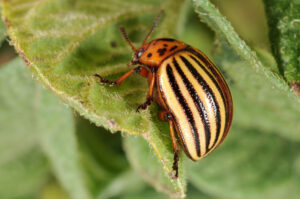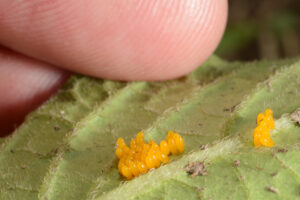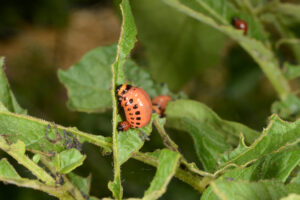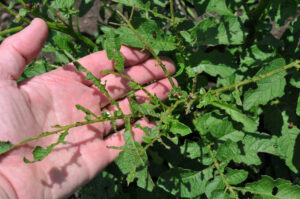The Colorado potato beetle (CPB) is one of the most devastating pests of potato crops and is something that you should be on the lookout for NOW! This pest overwinters as an adult in the soil or field margins surrounding last year’s crop. The soils have warmed, the adults came out and eggs are now hatching throughout the state. The adults are quite distinct, a dull yellow-orange color and ovalshaped (1/4-1/3 inch long) with 10 black stripes along its back (Figure 1). The eggs are a deep yellow color and oval shaped (Figure 2). As they begin to hatch, the young larvae have a black head and rounded orange abdomen. As they grow, the larvae turn to a more pink-orange color and develop two rows of black dots on the sides of their bodies (Figure 3). Like many insect pests, the sooner you spot them in your crop and apply a treatment, the more effective that control measure will be.
When do I need to intervene? It depends. Potato can sustain up to 30% defoliation prior to or after bloom without affecting yield (Figure 4). During bloom, however, the tolerable level of defoliation drops down to 6-8% before yield is impacted. While all stages of CPB feed on the plant, the third and fourth instar are the most damaging and can defoliate a plant in 1-2 days. These larvae are approximately ½ inch long.
Crop Rotation This cultural control can be effective if you can rotate the location of your potato crop at least half a mile from the previous year’s location. This distance requires the newly-emerging adults to walk and/or fly to the new location and few will make it that far.
Chemical Application CPB have been documented to develop resistance so careful selection and rotation of chemicals is key, regardless of organic or conventional use. For organic producers, Entrust® (a.i. spinosad), Trident® (a.i. Bt tenebrionis) and Azera® (a.i. azadirachtin and pyrethrin) have been shown to be the most efficacious products. For conventional producers, Coragen® (a.i. RynaXypyr), Blackhawk® (a.i. spinosad), Torac® (a.i. tolfenpyrad), Agri-Mek® (a.i. abamectin) and Cruiser® (a.i. thiamethoxam) seed treatment in various rotations and application rates are most effective. Refer to the Midwest Vegetable Production Guide for the most recent list of recommended products (mwveguide.org). Always follow label guidelines and recommendations; the label is the law.



